
- Magazine First Edition
- Contributors
- Alan Moore (14)
- C. S. Forester (6)
- Elmer Batters (10)
- George Quaintance (3)
- Howard Phillips (7)
- Hugh Hefner (14)
- John F Kennedy Jr (4)
- Kazuki Takahashi (4)
- Kohei Horikoshi (5)
- Landmark (3)
- Many (3)
- Mario (5)
- Multiple (5)
- Nintendo (12)
- Rachel Carson (6)
- Ralph Ginzburg (4)
- See Photo (3)
- Shirley Jackson (4)
- Unknown (4)
- Various (20)
- Other (3763)
- Features
- 1st Edition (946)
- 1st Edition, Graded (4)
- 1st Edition, Tmnt (4)
- Auto Racing (8)
- Cards (3)
- Collector's Edition (31)
- Complete Edition (3)
- Dust Jacket (4)
- First Edition (15)
- First Printing (6)
- Illustrated (37)
- Limited Edition (10)
- Lot (9)
- Nude (3)
- Original (4)
- Original Edition (4)
- Promo (2)
- Special Edition (8)
- Vintage (65)
- Vintage, 1st Edition (3)
- Other (2730)
- Genre
- Action & Adventure (25)
- Art & Photography (107)
- Celebrity (26)
- Comics (24)
- Fashion (46)
- Games (13)
- Gay & Lesbian (15)
- Gonzo (12)
- History (88)
- Horror & Monster (42)
- Lifestyle (12)
- Manga & Anime (14)
- Men (58)
- Movies & Tv (13)
- Music (32)
- News (24)
- Science Fiction (13)
- Sports (37)
- Superheroes (11)
- Video Games (58)
- Other (3229)
- Language
- Publisher
- American Media Inc (40)
- Antiquity (27)
- Condé Nast (71)
- George Newnes (65)
- George Newnes, Ltd (9)
- George R. Graham (6)
- Gerorge Newness (6)
- Harper & Brothers (12)
- Hmh (10)
- Hmh Publishing (17)
- Hmh Publishing Co. (6)
- Marvel Comics (8)
- Nintendo (32)
- Nintendo Of America (19)
- Nintendo Power (12)
- Playboy (36)
- Refill Magazine (7)
- Shueisha (15)
- Time (17)
- Time, Inc. (8)
- Other (3476)
- Topic
- Art (69)
- Art & Photography (17)
- Automobile (12)
- Books (12)
- Comic Books (27)
- Electronics (13)
- Fashion (61)
- Historical (30)
- History (23)
- Horror (23)
- Literature (19)
- Manga (19)
- Men's Interest (36)
- Modelling (42)
- Music (26)
- News (16)
- Photography (38)
- Poetry (12)
- Politics (38)
- Video Game (25)
- Other (3341)
Rare 1807 Curtis Botanical Hand-Colored Double Folio Engraving No. 995 POINCIANA

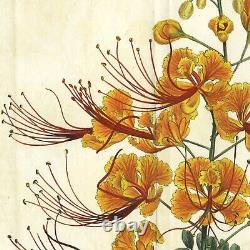
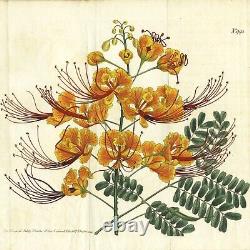
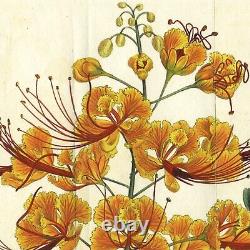
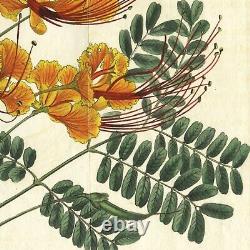
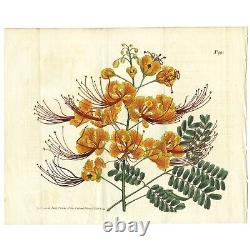

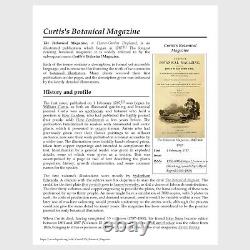


Rare 1809 Hand-Colored Copperplate Engraving from. The Botanical Magazine or Flower-Garden Displayed'. From early volumes of "The Botanical Magazine; or Flower-Garden Displayed" comes this original, Double, fold-out folio copperplate engraving, a rare & sought-after large-format plate from the scarce early volumes. This is my only copy of this stunning, lavishly-colored plate.
It's in near excellent condition for a print this old, about as beautiful a copy as I've seen. The drawing alone is quite magnificent, how each curling stamen is actualized from so many angles, The hand-painted veining on each ruffled petal.. Scanners don't seem to handle the subtle off-whites of antique print backgrounds very well, & often skew the other colors as well as the backgrounds.
I've done my best to correct the colors to actual. This plate is now extremely scarce, I find no other copies offered anywhere. If you've been wanting to collect one of the best of the large, early, fold-out Curtis prints, this is your chance to acquire a near pristine one. The Double-sized fold-out plates were reserved for the showiest, most dramatic, largest flowers. They were very rare in the series, & yet much more rare in the market, as they can often make the most impressive framed wall-art in terms of scale & image & are sought-after if & when one can be found. This plate is one of the classics of the Curtis volumes. This one is likely a First Edition print, which are generally very rare. Appears to be on the original wove paper, which came to be used in the early years of the 1800's. After the death of William Curtis, the magazine was published by his brother, Thomas Curtis. Later, Samuel Curtis (a son-in-law of William Curtis) became proprietor from 1801 to 1845. The prints in the first volumes were copper plates colored by hand.Some of the later prints were lithographs. Some of the distinguished artists were Sydenham Edwards, John Curtis, William Jackson Hooker, W. Fitch, William Graves and Matilda Smith.
These prints have a universal beauty and are a lasting documentary contribution to botanical studies. The Artists: This plate was engraved & hand-colored after a painting by Sydenham Edwards & is signed by'Syd. (Sydenham Teak Edwards, 1768 - 1819) as well as the engraver,'F. The drawing & composition are fluid, bold, lyrical, the coloring is stunning, brilliant, bright.
It's one of the boldest of the Sydenham Edwards double plates. These gorgeously drawn, engraved & water-colored original prints were presented on their page with consistently balanced, beautiful compositions. They are full of the passion that the early flower painters, botanists & gardeners had for these amazing flowers, many of which were discovered in the pristine reaches of the ever-expanding British Empire & by intrepid explorers of the time.
Every part of these prints was made by hand: Hand drawn & engraved on Copper which was hand-mined, smelted & rolled, printed onto handmade cotton rag paper, inked & colored with hand-ground pigments individually by hand, & they were usually hand sewn into handmade leather-bound books. Condition: Appears to be in excellent condition. The hand-coloring remains sharp & brilliant. The folds in this one are as-issued & appear in all copies I've seen of this plate, as it's a'fold-out' & much larger than the rest which were octavo-sized bookplates.
These prints are very old & may have minor imperfections expected with age, such as some typical age-toning of the paper, oxidation of the old original watercolors, spots, text-offsetting, artifacts from having been bound into a book, etc. Please examine the photos & details carefully. Text Page(s): This one comes with its original text page. Caesalpinia pulcherrima (as it's now known) is a species of flowering plant in the pea family Fabaceae, native to the tropics and subtropics of the Americas.
It could be native to the West Indies, but its exact origin is unknown due to widespread cultivation. Common names for this species include Barbados Flower-Fence, poinciana, peacock flower, red bird of paradise, Mexican bird of paradise, dwarf poinciana, pride of Barbados, flos pavonis, and flamboyant-de-jardin. Caesalpinia pulcherrima has these incredibly showy blossoms of orange and red. The striking orange-red flowers are an attention grabber in gardens & in the wild.
It is a striking ornamental plant, widely grown in domestic and public gardens in warm climates with mild winters, & the fact that it tolerates pruning well allows it to be planted in groups to form a hedgerow; it can be also used to attract hummingbirds. It's the national flower of the Caribbean island of Barbados, and is depicted on the upper left and right corners of the Queen Elizabeth II's personal Barbadian flag. Size: 9 x 12 inches approximately. If you'd like to combine & need more time to choose, please send a message & we'll do our best to oblige.
